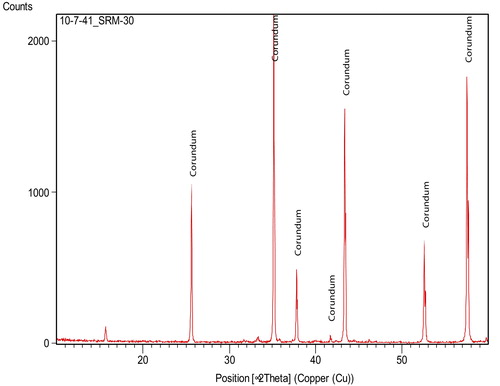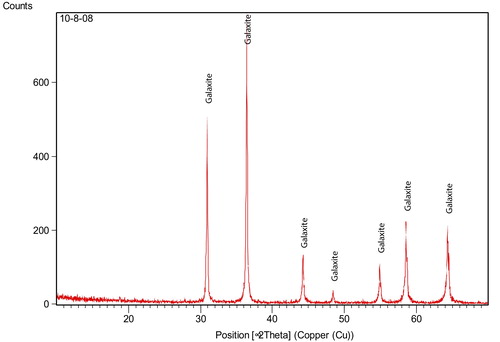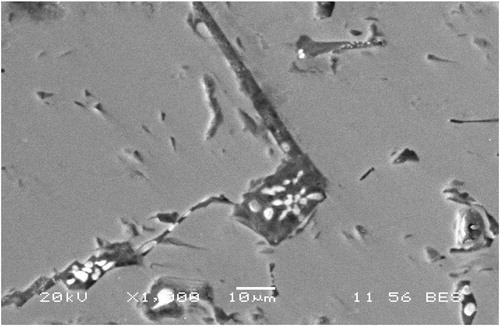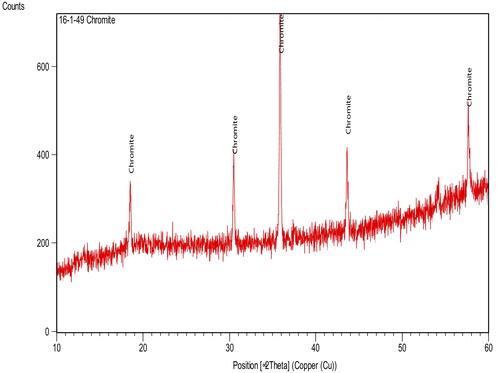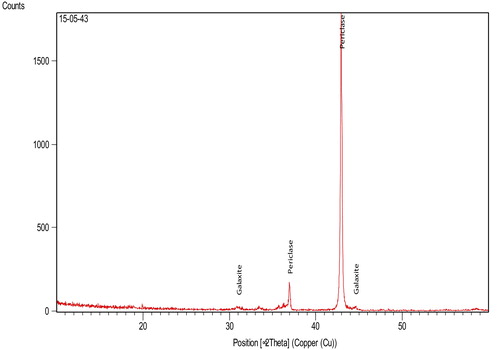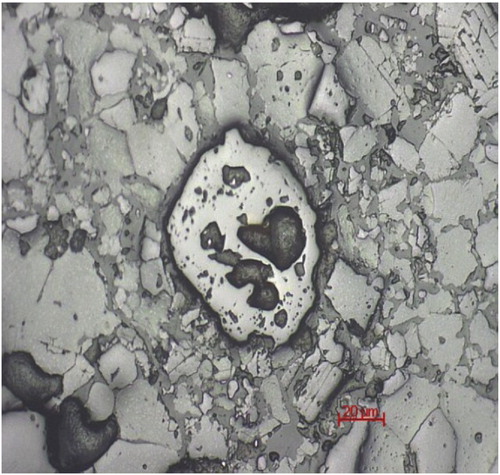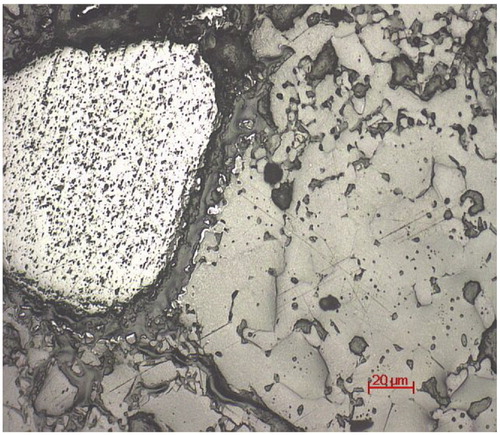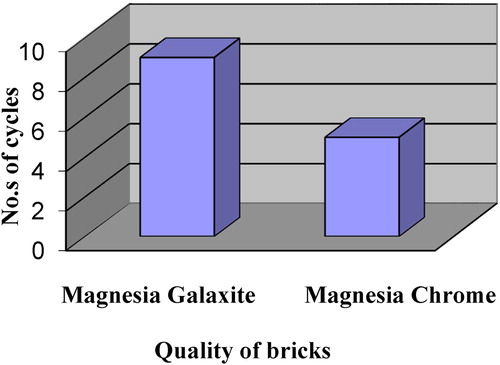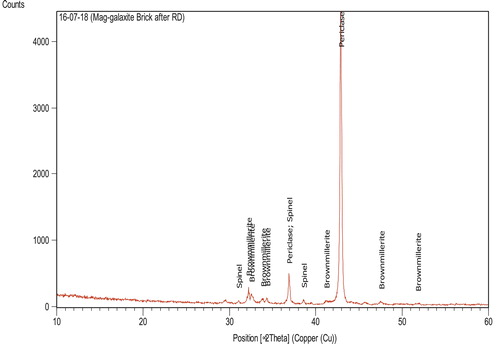Abstract
In India, chromite is used for making magnesia chrome bricks due to its low modulus of elasticity. But the use of magnesia chrome bricks in the sintering zone of cement rotary kilns causes environmental pollution due to the formation of Cr+6 compounds. In order to meet the above challenges and to satisfy the operational demands due to use of alternative fuels, now-a-days, galaxite spinel is being used in place of chromite as a chrome free material. Galaxite is not available in nature and electro fusion is the main process by virtue of which it is industrially manufactured. However, the main drawback of electro-fusion process is both time and energy consumption. In such a backdrop, the present work has been carried out which describes the synthesis of galaxite by plasma fusion process and also the characterization of its refractory properties for application in cement rotary kilns. This alternative process is absolutely new, faster in approach and also economically viable. The developed magnesia galaxite brick shows higher performance rate and is also economically cost effective as compared to the conventional magnesia chrome and magnesia galaxite bricks, presently available in the market.
1 Introduction
Historically different types of refractories have been utilized in the sintering zone of cement rotary kilns to meet the operational demands due to increased use of alternate fuels. In India, conventional magnesia chrome bricks have been used in the sintering zone of cement rotary kilns because of their high spalling resistance, corrosion resistance and good coating adhesion stability [Citation1 Citation2013;Citation3]. But the use of magnesia chrome bricks causes hexavalent chromium ion and on the other hand, disposal of these bricks pollutes the water and soil medium. Therefore more attention has been paid towards the development of chrome-free refractories for the sintering zone of cement rotary kilns [Citation4 Citation2013;Citation11].
Presently, galaxite spinel is increasingly used as a chrome free refractory because of its lower thermal expansion and greater thermal mismatch as compared to magnesia [Citation12 Citation2013;Citation20]. This spinel is also an active spinel and is found to be more effective because, addition of galaxite, instead of chromite to magnesia refractory, can withstand high mechanical loads as well as high chemical stresses and also reduces the loss of flexibility during the densification of brick structure by penetration of alkali salts [Citation21 Citation2013;Citation24].
From the existing literature, it has been found that galaxite is not available in nature and can only be prepared synthetically. To date, it is known that electro-fusion is the main processes by virtue of which galaxite is industrially manufactured. The advanced countries such as Europe, China and Germany manufacture magnesia galaxite bricks by producing synthetic galaxite through electro fusion process. But the main drawback of the electro fusion process is both time and energy consumption. On the other hand, plasma fusion technique is also available for preparation of fused material which is a new, faster and economically cheaper as compared to electro fusion process.
In the present study, efforts are made firstly to prepare galaxite by plasma fusion process by taking pure alumina and manganese dioxide powder as main raw material and evaluated the physical, thermal, chemical and mineralogical properties and secondly, to prepare magnesia galaxite bricks by taking synthetically prepared fused galaxite and sintered magnesia as raw material. Then their properties such as physical, thermal, mechanical, mineralogical, chemical and corrosion resistance are evaluated and compared with the magnesia chrome bricks to know its suitability for application in cement rotary kiln.
2 Experimental procedure
2.1 Synthesis of fused galaxite
First of all, fused galaxite is prepared by taking pure alumina and manganese dioxide powder as main raw material. The chemical and XRD analysis of alumina and manganese dioxide is given in . The formulation is also made for synthesis of fused galaxite and is given in . As per the formulation, alumina and manganese dioxide powder are mixed in a 5 kg Ball Mill for 30 min. Then the mixed materials are fused in an indigenously developed 50 kW DC Pot Type Extended Arc Thermal plasma reactor.
Table 1 Chemical & XRD analysis of alumina and manganese dioxide powder.
Table 2 Formulation for synthesis of fused galaxite.
2.2 Evaluation of fused galaxite
After synthesis of fused galaxite, the physical, thermal and chemical properties of fused galaxite and chromite are evaluated and are given in . The physical properties such as bulk density and specific gravity are evaluated as per the ASTM C 493-98 by Mercury Volumino Meter and BIS 1528 part IX method respectively. The thermal property such as thermal expansion is carried out by a Dilatometer. The mineralogical properties of fused galaxite are evaluated by SEM & EDAX and X-ray diffractometer analysis by PANalytical X’Pert PRO by using Cu–Kα radiation. The chemical analysis of fused galaxite is evaluated by the standard wet chemical method as per the BIS 1527.
Table 3 The physical, thermal and chemical properties of fused galaxite and Chromite.
2.3 Preparation of magnesia galaxite and magnesia chrome bricks
Sintered magnesia having 97.3% MgO is taken for the preparation of above mentioned bricks. After evaluation of properties, the raw materials-sintered magnesia, fused galaxite are crushed and ground into different fractions for getting the required size. Synthesis of fused chromite is not required because it is naturally occurring and is available in the market in the size fraction of 0–1 mm. In India, refractory manufacturers are using about 10% of chromite for the preparation of magnesia chrome bricks which are used in the sintering zone of cement rotary kilns. Therefore, accordingly composition is made for preparation of magnesia galaxite and magnesia chrome bricks and is given in . As per the composition, the above raw materials are mixed thoroughly with dextrin, molasses and water for 20 min in a Countercurrent Mixer (Eirich make). Bricks are prepared by Friction Screw Press (FSP) of 400 t capacity. The size of the brick is 180 × 115 × 65 mm and the bulk density is 3.10–3.12 g/cc. Then the bricks are dried in an oven at 110 °C for 24 h. After drying, the bricks are fired in tunnel kiln at a peak temperature of 1580 °C for 8 h.
Table 4 Composition of magnesia galaxite and magnesia chrome brick.
2.4 Evaluation of magnesia galaxite and magnesia chrome bricks
The physical, thermal, mechanical and chemical properties of both the bricks are evaluated and compared and are given in . The physical properties of both the bricks such as apparent porosity, bulk density, cold crushing strength, modulus of rupture and the thermal properties such as refractoriness under load, thermal expansion and permanent linear change are evaluated as per the Bureau of Indian Standard IS-1528 method. Thermal conductivity is tested as per the IS 9490 method. The modulus of elasticity is measured by a DEPA equipment test apparatus as per the ASTM 2001 section 15 Vol 15.01C 885-97.
Table 5 Comparison and evaluation of physical, thermal, mechanical and chemical properties of magnesia galaxite and magnesia chrome brick.
The spalling resistance by air quenching method is evaluated as per the IS 1528 Part 7 and the same by water quenching method is carried out at 1300 °C by using sample size 50 mm diameter and 50 mm height. The sample is heated at a heating rate of 5 °C per minute to 1300 °C and kept for 30 min. Then the sample is removed from the furnace and kept in cold running water for 3 min and then kept in an oven where the temperature is 110 ± 5 °C for 30 min. This is for the first cycle. After that, the sample is inserted into the furnace at 1300 °C for 15 min and kept in water for 3 min than in oven for 30 min. This cycle is repeated until detachable of the sample.
The mineralogical properties of bricks are evaluated by an optical microscope (Carl ZEISS Scope.A1) under reflected light, and Phase analysis is done by X-ray diffractometer by PANalytical X’Pert PRO by using Cu–Kα radiation.
The corrosion resistance against cement clinker & alkali is also evaluated by rotary drum apparatus at 1650 °C using cement clinker and potassium sulphate. Nodules are prepared by mixing 400 g of cement clinker with 32 g of K2SO4 and then dried. The rotary drum is lined with the cut piece of the refractory bricks. The temperature of the rotary drum is raised to 1650 °C by a gas fired burner. Then 432 g of dried nodules are fed into the rotary drum and kept for 3 h. This is repeated for 5 cycles. After the test, coating formation and resistance of both the bricks against cement clinker and alkali are observed.
3 Result & discussion
The XRD graph of alumina and manganese dioxide powder shows corundum and pyrolusite as major phase and is given in respectively. The bulk density and true porosity of fused galaxite are 3.84 g/cc and 5.88% respectively. The thermal expansion of fused galaxite at 1000 °C is 0.90%. The XRD graph and SEM Photomicrograph of fused galaxite are given in respectively. The XRD graph shows galaxite as major phase which is also confirmed by SEM & EDAX analysis. In addition to galaxite phase, little amount of glassy phase (Low melting compound) is found in the inter-crystalline space of fused galaxite which is found from the SEM and EDAX spectra analysis. The XRD graph of chromite shows chromite as major phase and is given in .
The XRD graph of magnesia galaxite brick shows magnesia as major phase and galaxite as minor phase as given in . Similarly magnesia chrome brick shows magnesia as major phase and chromite, magnesio–ferrite, magnesio–chromite as minor phases as given in . The photomicrograph of magnesia galaxite and magnesia chrome brick also confirms the same and are given in respectively. shows the comparison of spalling resistance of both the bricks by water quenching at 1300 °C.
From the comparison of physical, thermal and chemical properties of magnesia chrome and magnesia galaxite bricks, it is observed that the apparent porosity and the bulk density values are almost same. The cold crushing strength, modulus of rupture, refractoriness under load and the spalling resistance by air quenching at 1000 °C as well as by water quenching at 1300 °C (As per DIN method) values of magnesia galaxite bricks are higher than those of magnesia chrome bricks. The thermal expansion values of both the bricks are almost same. But the thermal conductivity of magnesia galaxite bricks is lower as compared to the magnesia chrome bricks. Similarly the modulus of elasticity of magnesia galaxite brick is lower than the magnesia chrome brick. The comparison of modulus of elasticity of both the bricks is given in . This may be due to the galaxite causes a thermal misfit, which results from its lower thermal expansion compared to surrounding magnesia matrix and in addition, galaxite gains additional flexibility due to the continuous process of Mn+2 and Mg+2 diffusion.
Fig. 11 Comparison of modulus of elasticity of magnesia galaxite (MG) and magnesia chrome (MC) brick at 1400 °C ↔ RT.

In magnesia galaxite brick, Mn+2 ions from galaxite migrate into the magnesia matrix resulting in a surplus of alumina within the galaxite grain. Furthermore, Mg+2 ions partially diffuse into the galaxite grains. The supplied magnesium reacts with the surplus alumina from the galaxite to form the in situ spinel MgO·Al2O3. This reaction entails a further volume expansion, thereby providing additional flexibility. This flexibilizing effect of the active galaxite spinel is maintained during the entire operational period due to the continuous process of Mn+2 and Mg+2 diffusion. The flexibilizing effect of galaxite spinel and firing temperature giving the brick a high bonding strength as well as high chemical corrosion resistance without losses in microstructural flexibility. Combining these counteracting brick properties ensures a high durability of the brick, which is particularly important in the case of critical operating conditions [Citation25].
The corrosion resistance against cement clinker & alkali of both the bricks is evaluated by rotary drum equipment. From the above test, it is observed that developed magnesia galaxite bricks show higher corrosion and alkali resistance than magnesia chrome bricks. Then mineralogical properties such as microscopy and XRD analysis of developed magnesia galaxite brick are evaluated to know the cause of higher resistance as compared to magnesia chrome brick. The photomicrograph of magnesia galaxite brick after rotary drum test shows the presence of magnesia alumina spinel phase and also C2 (A, F) solid solution in the matrix part which is located in the areas between magnesia grains and is given in . Similarly, the XRD graph of magnesia galaxite brick after rotary drum test also confirms the same and is given in which is also in conformity to the observation of Jorg and Krischanitz [Citation25].
4 Conclusions
| • | Fused galaxite can be synthetically prepared by plasma fusion process using alumina and manganese dioxide powder. | ||||
| • | Fused galaxite has high bulk density and lower true porosity percentage. | ||||
| • | Thermal expansion property is similar in the case of fused galaxite and chromite. | ||||
| • | The developed magnesia galaxite bricks have high cold crushing strength, modulus of rupture, refractoriness under load, spalling resistance (both in air & water quenching method), and corrosion resistance to cement clinker and alkalies and, lower thermal conductivity as compared to magnesia chrome bricks. | ||||
| • | Values of higher spalling resistance determined by both air and water quenching method and lower thermal conductivity indicate that the developed magnesia galaxite bricks have higher thermal shock resistance than those of magnesia chrome bricks. | ||||
| • | Higher corrosion and alkali resistance of developed magnesia galaxite bricks as compared to magnesia chrome bricks may be due to the formation of magnesia alumina spinel phase and (C2 A, F) solid solution in the matrix part as conformed by XRD analysis. | ||||
| • | The developed magnesia galaxite brick shows higher performance and is also economically cost effective as compared to conventional magnesia chrome and magnesia galaxite bricks which are available in the market. | ||||
| • | Therefore the developed magnesia galaxite bricks can replace magnesia chrome bricks in cement rotary kilns which will ultimately reduce the pollution of hexavalent chromium in the water medium on disposal of used refractory bricks. | ||||
Acknowledgements
Authors are thankful to Department of Science & Technology, Govt. of India, for sponsoring the project and also Dalmia Institute of Scientific & Industrial Research, Rajgangpur, Odisha for publishing this research work.
References
- G.LiuN.LiW.YanG.TaoY.LiJ. Ceram. Process. Res.132012480485
- S.GhanbarnezhadA.NematiM.Bavand-VandchaliR.NaghizadehJ. Chem. Eng. Mater. Sci.42013712
- P.BarthaH.J.KlischatCN-Refractories619993138
- H.KomatsuM.AraiS.UkawaTaikabutsu Overseas19199939
- S.SerenaM.A.SainzA.CaballeroJ. Eur. Ceram. Soc.24200423992406
- S.SerenaM.A.SainzA.CaballeroJ. Eur. Ceram. Soc.29200921992209
- J.L.R.GaliciaA.H.D.AzaJ.C.R.AngelesP.PenaJ. Eur. Ceram. Soc.2720077989
- J.SzczerbaCeram. Int.36201018771885
- G.LiuN.LiW.YanG.TaoY.LiJ. Ceram. Process. Res.132012480485
- S.GhanbarnezhadA.NematiM.B.VandchaliR.NaghizadehJ. Chem. Eng. Mater. Sci.42013712
- S.C.SharmaS.GopalTrans. Indian Ceram. Soc.531994116129
- G.LiuN.LiW.YanC.GaoW.ZhouY.LiCeram. Int.40201481498155
- J.ChenM.YanJ.SuB.LiJ.SunCeram. Int.422016569575
- G.LiuN.LiW.YanC.GaoW.ZhouY.LiCeram. Int.40201481498155
- P.BarthaH.J.KlischatZKG Int.471994277280
- J.WojsaJ.PodwórnyR.SuwakCeram. Int.392013112
- J.MukerjiS.N.GhoshAdvances in Cement Technology1983Pergamon265287
- M.K.HaldarH.S.TripathiS.K.DasA.GhoshCeram. Int.302004911915
- J.SzczerbaCeram. Int.36201018771885
- G.GelbmannR.KrischanitzS.JorgRHI Bull.220131012
- N.JosefZ.Q.GuoS.ShiRHI Bull.320061517
- J.E.ContrerasG.A.CastilloE.A.RodriguezT.K.DasA.M.GuzmanMater. Charact.542005354359
- J.H.ChenL.Y.YuJ.L.SunY.LiW.D.XueJ. Eur. Ceram. Soc.312011259263
- G.MartinM.ChristianW.AndreasRHI Bull.120032528
- S.JorgR.KrischanitzRHI Bull.32006710

